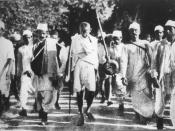Salt duties had been a feature of The Government of India since Mughal times. In order to augment the state revenues, a law was passed by The Government of India to create the Salt Tax throughout India. The Salt Tax prohibited the private manufacture of the salt and made possession of the salt derived from non-government sources illegal. In 1930, The Government of India had a monoply on the salt, which made it the only one who could sell the salt, and tax the people whenever they bought it. Furthermore, in order to make up the revenue lost due to the decreasing export tax, the Government of India increased the Salt Tax. By this time, the Indian National Congress, the largest political opposition party in India was working hard to take India out from the throes of turmoil. But the Congress lacked any specific program of action which can be launched against the Government of India, so the Congress party delegated ÃÂMohandas Karamchand Gandhi,ÃÂ one of IndiaÃÂs most chirasmatic and renowned personality, as their leader in the project of gaining IndiaÃÂs Independence.
To Gandhi, the Salt Tax was a symbol of British oppression that he wanted to end. So, Gandhi began a new campaign in 1930, ÃÂthe Salt Satyagraha movement.ÃÂ The Salt Satyagraha movement was a campaign of non-violent protest against the Government of India, which was led by Gandhi and his followers by marching from his Ashram to the Sea where he wanted to target the state monoply on salt by picking up a few grains of salt. However, Gandhi complained about the Salt Tax in order to gather large public support. By choosing salt as the main issue, Gandhi wanted to fulfil several purposes at one stroke. Because salt is essential for human existence, all classes...


